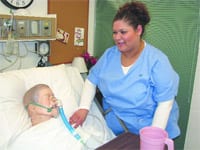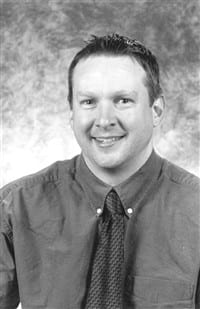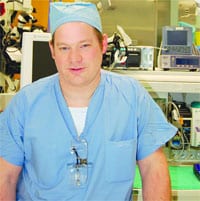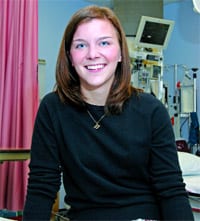Getting a Needed Push Grant Program Helps Entry-level Workers Transition into Patient Care
Dan Boze was already quite familiar with the orthopedic unit on the sixth floor at Baystate Medical Center when he started his first overnight shift there as a patient-care technician, or PCT, as they’re called, on March 14.
That’s because he used to push a broom down its hallways.
Indeed, only a few months ago, Boze was working as a custodian at Baystate, a job he says he took to get his foot in the door and maybe someday make a career shift into patient care. His work in custodial services covered three floors in the Daly Building, 4-6, and when he graduated a few weeks ago from a program designed to put more patient-care workers in the pipeline, Boze had the opportunity to choose either the orthopedics unit or the pediatrics wing on Daly 4, another place where he used to clean restrooms.
Making the transition from janitor to a PCT, where he is checking patients’ vitals, inserting catheters, checking blood sugar, and assisting nurses in myriad other ways, and on floors he used to clean, has been “a little weird,” said Boze. He noted quickly, however, that such feelings have been supplanted by thoughts about how his familiarity with those units is to his advantage, and also focus on the mental and physical challenges of transitioning from the day shift and five eight-hour days to the night shift and three 12-hour days.
These days, Boze is more than a proud PCT with thoughts already turning to the next stage of his career in health care — probably as a nurse or surgical technician; he’s also the perfect spokesperson for the workforce-development program, which is designed to help entry-level workers get the training they need to transition into patient care.
“This is a like a dream come true,” he told The Healthcare News. “I always wanted to work with people, and this program gave me the push I needed to pursue my goals and my dreams.”
There are nine other individuals, all saying the same kinds of things, if perhaps not as eloquently, now working as PCTs, or certified nursing assistants, as they’re also called. These 10 — seven from Baystate and three from Mercy Medical Center — are the first to ‘graduate’ from the program, funded by the Workforce Competitiveness Trust Fund. The next stage in this initiative is to take 45 external candidates — those who are unemployed or underemployed — and enroll them in the same training regimen, said Dan Bates, a human-resources generalist at Mercy and one of those administering the grant.
Training these external candidates to be PCTs is step one, said Bates, adding that the ultimate goal is for these workers to make their way up the career ladder to positions ranging from registered nurse to physical therapist to laboratory technician. In so doing, they will help alleviate projected shortages that will stem from increased demand for health care services due to an aging population and the retirement of the Baby Boomers now dominating the workforce.
Climbing more rungs will take education and perseverance, he continued, adding that the program is designed to build confidence and show individuals that they have what it takes to advance their careers.
“This is just the starting point,” he said, noting that participants from Mercy are already thinking about the next steps.
Sylkia Paine is one of them. A now-former secretary in the Med-Surg unit at Mercy, she, too started work as a PCT in mid-March, and is already eyeing enrollment in Elms College’s Nursing program in the fall of 2010.
“This program is going to make it easier for me to get accepted,” said Paine, who spoke to The Healthcare News while wrapping up her PCT training with work on simulators at the SIMS Medical Center at Springfield Technical Community College. “I’m now getting hands-on work with patients that is invaluable.”
Registering Results
Ashley Lapointe has a story similar, in many ways, to Boze’s.
Only a few months ago, she was toiling in the gift shop at Baystate Medical Center. It wasn’t bad work, especially given the economic conditions, whereby any job is a good job, but it certainly was not what Lapointe wanted to be doing for a living.
Instead, she preferred to be on or much nearer to the front lines in patient care. But she lacked most all of the requisite experience when she applied for such jobs several months ago (one college course in Phlebotomy to that point) so when Baystate offered her a job behind the counter at the gift shop, she took it.
But last Sunday, she probably walked past that facility on the way to her new job as a PCT on the Neurology Unit on what’s known as Wesson 4.
There were many similar scenarios being played out over the third weekend in March, as the chosen 10 moved on and up to new positions in health care. Their former assignments varied — from dietary aide to grill cook; from secretary to patient registration representative; from counter person at Friendly’s to orderly. The common denominators, from a career perspective, were a desire to be working with patients, challenges from everyday life with regard to finding the time and resources to get the training required for such a career leap, and the need for a push, as Boze described.
Employees at Baystate and Mercy had to apply for the right to be chosen to take part in the first stage of the program, and as part of that process, they had to write a quick essay explaining their desires and motivations.
Amy Rist, project coordinator at Baystate and one of those administering the grant program, provided The Healthcare News with some of those essays, while keeping the writers’ names confidential. They speak directly to what the ambitious program is all about.
“I feel that this is an important opportunity to gain a higher level of a health care experience,” wrote one of those eventually chosen, “and a chance for better income. Becoming a patient care technician plants me firmly on the path to my career goals and provides an excellent opportunity to help those in need.”
Wrote another of the chosen seven: “I would like to participate in this program because it would give me the satisfaction of being able to change the quality of life of different people. I know this is a great opportunity for me to better myself as a person and be able to render my services to those people less fortunate. I have always been a people person, and this would allow me to continue helping and making people’s lives better.”
And there was this from a third chosen to participate: “I would like to participate in this program because I’m a married, separated mom with two older children. I was interested in getting into the medical field when I was younger, but I had my children and had to attend to them, so my thoughts were put on hold. Now, my children are older … and this program came along, and I figured it was an opportunity to do something I was interested in doing.”
Rist said these offerings and others like them explain why the grant was sought and what it will do.
“It’s often difficult for entry-level workers to get the training they need because of family responsibilities or working a second job,” she explained. “Overcoming this barrier is one of the goals of the program — to make training easily accessible.”
Bates agreed. He said many of those chosen for the program have thought about making the transition to patient care but have not been able to until now because of life constraints and challenges.
The program enables participants to effectively take leaves from their jobs, with their employers continuing to pay them their salaries, and the grant paying for their tuition and other expenses such as day care. Those chosen attended classes for 10 weeks at either Holyoke Community College or the Mass. Career Development Institute, with acute-care training at the SIMS Medical Center capping the experience.
Employment as PCTs gives program participants a significant increase in wages (10{06cf2b9696b159f874511d23dbc893eb1ac83014175ed30550cfff22781411e5} to 20{06cf2b9696b159f874511d23dbc893eb1ac83014175ed30550cfff22781411e5} by most estimates), but also, and perhaps more importantly, a real boost in confidence, said Rist, adding that it will also provide exposure to patient-care work and the kind of hands-on experience that can propel people into other careers in health care.
Paine, now working the second shift in Mercy’s so-called Ortho-Neural unit, agreed.
“I had made up my mind to be a nurse long before this opportunity came about,” she explained, adding that the workforce program should accelerate the process of reaching that goal. “But this program will definitely help by giving me hands-on experience and the ability to interact with patients. I’ll be able to experience direct patient-care work, rather than being in the back seat like I was, just looking around and not having anything to do with care delivery.”
Lapointe also has ambitions to become a nurse, and told The Healthcare News that work as a PCT will help her determine if this is really what she wants to do — while also bettering her chances to win a seat in a Nursing program, if that’s the route she opts to take.
And she probably wouldn’t have been able to take the first step in the process without some help.
“I could have done this on my own, if I had wanted to pay for it, but it would have been more difficult,” she said, “because I would have had to work and go to school at the same time. This program made it a lot easier — it was a great opportunity for me to get ahead.”
Mop-up Work
As he talked with The Healthcare News, Boze had just wrapped up his first three-day workweek as a PCT. He was tired, but didn’t have to go back to work on Daly 6 for three days, so he had some time to talk.
He said the leap from custodian to patient-care provider is one he probably wouldn’t have made without a push, and he’s happy to have been provided with one. And, as program administrators would hope, he’s already thinking about that next rung.
“From here, I’d like to get into nursing or maybe work as a surg tech,” he explained. “I know I want to work with people and in patient care; I just need to decide which way I want to go.”
He’s already made one big decision, and it’s led to some sweeping changes in his life — literally and figuratively — with more apparently to come.





Comments are closed.